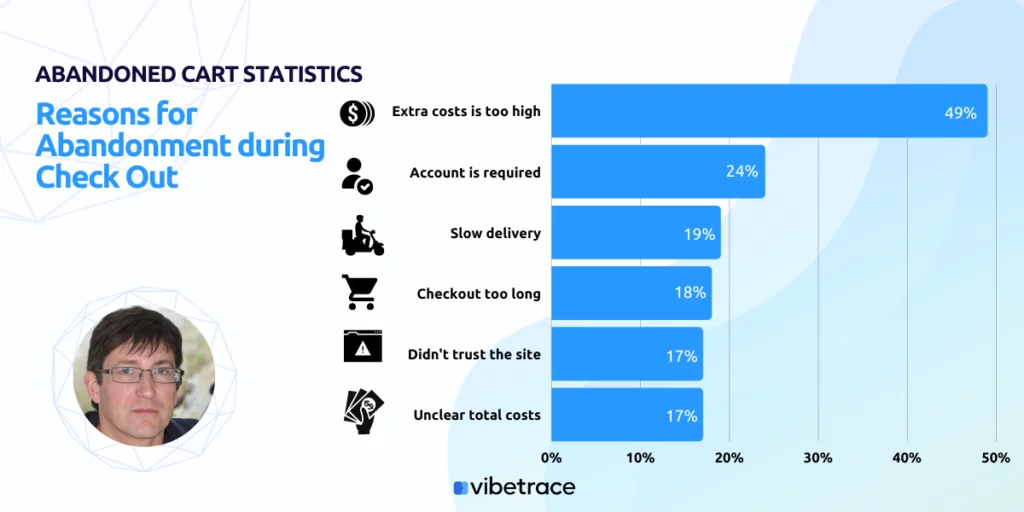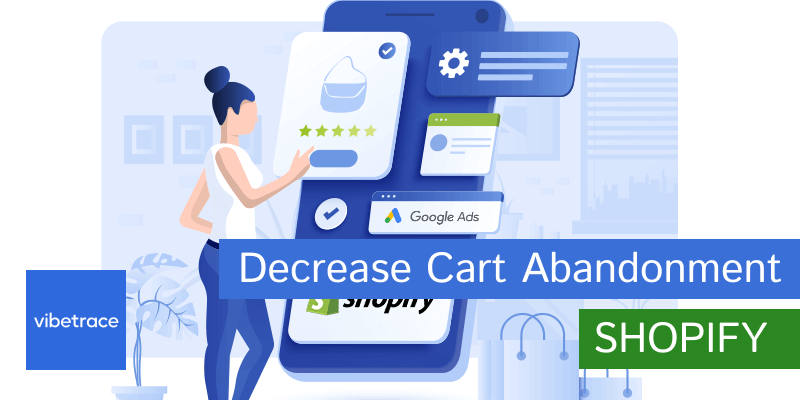Do you want to boost your Shopify store’s revenue? Then think about the staggering 70% cart abandonment rate. Does your store have these dramatic results? Are you leaking profits?
The good news is that with versatile tools and strategies, you can tweak your store and marketing efforts to reduce the percentage of abandoned carts and checkout processes. That’s what we’ll be discussing today.
Before we delve into the solutions, you need to better understand cart and checkout abandonment rates and how they differ. That way, you can adjust your approach to both. Let’s get started!
What’s Cart Abandonment on Shopify?
Window shopping happens online as much as it happens offline. It’s in our nature to “just browse”. That’s just what leads to cart abandonment.
When a customer abandons their cart on a Shopify store, it shows they put products in the cart but left the website before initiating and completing a purchase.
Those prospects are more likely to purchase if they return than the visitors who generate the so-called browse abandonment rate.
Cart abandonment is not uncommon. Often, the reason for it is beyond your control as a store owner or manager. In fact, 58.6% of online shoppers in the US abandoned their cart at least once in the past 3 months simply because they weren’t ready to make a purchase. (Baymard Institute).
A higher cart abandonment rate gives you insights into:
- The overall user experience;
- The general usability, accessibility, and UI;
- The level of personalization;
- How to improve all that.
Don’t forget that people might’ve gotten distracted, had trouble navigating your website, or have been window shopping.
The checkout abandonment rate offers a much more painful indicator of your Shopify store’s performance.
Below, we’ll solve the mystery of why people abandon the checkout process.
Why Do People Abandon the Checkout Process?
Checkout abandonment expresses the situation in which a customer has initiated the checkout process and took at least the first step in it, but didn’t complete the purchase.
That’s rarely the result of a distraction or not being ready to purchase at that moment.
On the contrary, those customers signal that something went wrong during the checkout process. The cost of shipping is the most common reason for failing a purchase.
Imagine someone purchasing a $20 tank top with a $34.99 shipping cost. 48% of online shoppers will abandon checkout if such costs are too high.
Another 24% percent will abandon the process if they’re forced to create an account. That’s why we always advise you to add guest checkouts to your Shopify store. The convenience of it is what will often make customers return and, eventually, create an account.
Other popular reasons for checkout abandonment include reluctance to share payment and personal information with the store (18%), a complicated overall process with too many steps (17%), a faulty website that crashes (13%), even a lack of variety in payment methods (9%). (Baymard Institute)

That’s why it’s so important to get to know your customers, track your visitors, and divide the base into specific segments with narrower characteristics. You’ll better understand their needs, preferences, and pain points.
And then you’ll be able to address them efficiently.
Tracking visitors helps with something else – you’ll be able to separate the cart from the checkout abandonment and take corresponding measures. We’ll see how in the next section.
Full list of cart abandonment reasons and how to address them.
Difference Between Cart and Checkout Abandonment
Cart and checkout abandonment differ according to the stage of the user journey they occur in:

- Cart abandonment can occur at every stage of the journey, from the very moment a person visits your site and adds a product to their cart.
- Checkout abandonment requires people to have initiated the checkout process, virtually completing their journey, for it to count.
Given that, you’ll have to address both abandonment rates differently. The website’s UI, the overall user experience you offer, and the cart page itself all influence shopping cart abandonment. Checkout abandonment depends on the checkout and payment pages, as well as the costs involved.
If many people drop off your site once they start the checkout process, go through it yourself. There might be bugs or terms, policies, and information that don’t display properly, and a whole plethora of technical problems.
To reduce checkout abandonment, focus on the technical aspects, the availability of payment options, and on making the process as smooth and painless as possible. To reduce shopping cart abandonment, explore and use one of the powerful strategies we share below.
7 Ways to Decrease Cart Abandonment on Shopify Stores
Sometimes people forget about browsing your store and get distracted, and sometimes they’re just tough prospects. Either way, there’s a lot you can do to prevent visitors from ghosting you.
When 7 out of 10 people put something in their carts and leave without even initiating the checkout process, you must take measures to staunch the bleeding. Here are some ideas you can apply immediately:

1. Abandoned Cart Emails
When you capture emails to build your email marketing lists, you can identify the people who visit your website and abandon their carts. Use apps like VibeTrace to segment those customers into dedicated lists and target them with specific offers.
Another great application of solutions like VibeTrace is the ability to set in place automated email workflows focused on recovering abandoned carts on your Shopify store.
With such workflows, when a registered user abandons their cart, they receive an email automatically after a certain amount of time.
How long to wait? Between 30 minutes and an hour. You can add a second and even a third email to your abandoned cart recovery workflow if the first email doesn’t cut it.
The best part is that the subtle nudge can contain an incentive – a discount code, a limited-time offer, a redeemable gift in case customers complete the purchase, and so on.
If you think an incentive within the email can help reduce the cart abandonment rate, don’t hesitate to use one.
But what to do when the visitors who abandon the most carts aren’t registered and you don’t have their email? We’ve got you covered!
2. Retargeting Ads
Retargeting ads are the best way to keep the attention of first-time visitors who’ll most likely leave your website without purchasing. In fact, most first-time visitors would never make a purchase.
Apps like AdRoll and Rontar Dynamic Retargeting Ads help you find visitors while they’re browsing the web. The neat thing about retargeting is that you can display ads only to those people who put something in their shopping cart and then left.
That way, you can find the people interested in your products and target them with what they want.
But if you don’t want to chase people once they leave your Shopify store, you can easily attempt to stop them on your store, as you’ll see next.
3. Exit-intent Pop-ups & Time-Sensitive Discounts
According to our research, exit-intent pop-ups that aim to prevent cart abandonment have a conversion rate of 17.12%.
Those trigger an instant response and can entice visitors to stay on your website. They appear at the exact moment someone tries to leave your website.
To prevent cart abandonment, you can set different exit-intent pop-ups with time-sensitive discounts and redeemable offers if visitors who’ve put something in their cart complete a purchase right now.
The best part is that you can target both registered and visitors without an account.
4. Push Notifications
Push notifications provide you with another superb instrument for re-engaging anonymous visitors. If they enable them for your Shopify store, you can nudge them with follow-up push notifications whenever they abandon their cart.
Push notifications offer prime real estate to capture your audience’s attention with exclusive and time-sensitive offers. Apps like PushOwl help you easily set up and manage those bite-sized promotional messages.
5. UGC & Social Proof
Product reviews, user-generated content, and even live updates on recent purchases help build trust. First-time visitors are least likely to purchase, but customer testimonials and feedback can tip the scales in your favor.
Such content helps demonstrate your products in action and decreases any objections prospects might have. Apps like Rivyo allow you to easily build social proof to reduce abandoned carts.
6. Reduced Costs
Associated costs play a vital role in prospects’ decision to proceed with and complete checkout or leave your store. If you can help them reduce those costs, advertise it.
Maybe you offer a variety of payment methods, or you use the Shop Pay app that allows paying in installments. Do you provide free shipping at certain thresholds?
People tend to abandon their carts because the cost of buying is unreasonable, the payment methods are not varied enough, or they don’t find a convenient option. Optimize your Shopify store with that in mind.
7. Simplified Checkout
Another crucial reason people abandon not just window shopping but the checkout process itself. If prospects must jump through 10 hoops, they’ll leave you for a store that has only 5 hoops.
According to Capterra, the checkout process must take less than 4 minutes if we want prospects to complete it. Make it as easy as possible for people to convert. Allow the option to purchase as a guest – the same research shows that 43% of consumers prefer that method.
Ensure there aren’t technical difficulties and pages don’t break across different devices. Rigorously test the checkout process, especially if you start seeing high abandonment rates once the process has begun. That’s a clear sign there’s a technical problem.
Remember, the average cart abandonment rate in e-commerce reaches a staggering 70%. If you employ a fraction of those strategies, you’ll set your Shopify store on a course to better overall performance.
Stop Bleeding Shopify Profits
Shopify store visitors will assess every element of your store, every bit of copy, and the way you address and communicate with them.
That assessment will influence the overall experience at every stage of the user journey and will impact the cart and checkout abandonment rates.
Now that you better understand why people abandon carts and the entire checkout process, you can start working towards reducing those rates.
Store owners and managers must be proactive – prospects have wildly different objections, and it’s up to you to overcome them, build trust, and gain credibility.
Once you do that, more people will start moving from the cart through the checkout to the thank you page.

